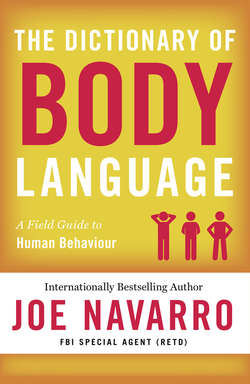Читать книгу The Dictionary of Body Language - Joe Navarro, Joe Navarro Toni Sciarra Poynter - Страница 6
The Forehead
ОглавлениеFrom the time we are babies, we begin to scan the forehead for information. Even at just a few months of age, infants will respond to the furrows on their mother’s forehead—perceiving it as something negative. This small space between the bridge of the nose and the hairline reveals to others, in real time, how we are feeling. It is a remarkable part of the body closely connected to the brain, which allows us to communicate sentiments quickly, accurately, and prominently.
19. FOREHEAD TENSION—On some individuals, stress manifests as sudden tension of the forehead, a result of the stiffening and tensing of underlying muscles. The face has more than twenty distinct muscle groups that can create more than four thousand distinct expressions, according to Dr. Paul Ekman. Six muscles in particular, including the large occipitofrontalis, the procerus, and the temporalis, account for the tightening or furrowing of the forehead when we are stressed. Obviously, one has to see people in a calm environment to get a baseline read on their forehead, but when people are stressed, tension of the forehead is frequently very noticeable and is an excellent indicator that something is wrong.
20. FOREHEAD FURROWING—Furrowing of the forehead in response to a stimulus is usually a good indicator that something is amiss, there are issues, or a person is insecure. It is also seen when people are concentrating or trying to make sense of something. Furrowing of the forehead is usually associated with doubt, tension, anxiety, or concern. Keep in mind that Botox, which many use for cosmetic purposes to obscure stress lines on the forehead, might mask true sentiments.
21. BOTOXED FOREHEAD (ISSUES)—Both men and women are now taking advantage of Botox injections to erase stress lines on their foreheads. This has created problems for couples and even for children who would normally look to the forehead for information as to how a person might feel. Babies as young as four weeks old will respond to a furrowed forehead as something negative. Interestingly, both children and adults have reported an inability to read their parents or their spouses who have used Botox for emotional cues as easily as they could before.
22. STRESS LINES—On some individuals, their life struggles are marked by deep grooves on their forehead, even at a young age. Life experiences often etch our foreheads with lines, furrows, and other indentations. The forehead can reflect a difficult or stressful life or a life that has been spent outdoors in the sun, which tends to make forehead markings more prevalent.
23. FOREHEAD SWEATING—If the degree of stress is high enough, some people begin to spontaneously sweat. Sweating is very individual. Some sweat profusely with their first sip of coffee, or climbing a flight of stairs, so make sure to get a baseline of this behavior before jumping to any conclusion. Baseline behaviors are those behaviors we equate with “normal,” when a person is not stressed or overly affected by emotions.
24. TEMPLE VEIN THROBBING—When a person is under stress, the superficial temporal veins (those nearest the skin on the sides of our heads and just behind the eyes) might pulse or throb visibly. It is a very accurate indicator of autonomic arousal due to anxiety, concern, fear, anger, or, occasionally, excitement. Autonomic arousal is the brain’s way of automatically going into survival mode—compelling the heart and the lungs to work faster in anticipation of physical activity such as running or fighting.
25. FOREHEAD MASSAGING—We tend to massage our foreheads when we have headaches (literally), when we are processing information, or when we have worries, concerns, doubts, or anxiety. It is a pacifying behavior, which helps to soothe tension or apprehension.
26. POINTING AT FOREHEAD—Pointing a finger at the forehead or making a screwing motion with the finger while pointing at the forehead is very insulting—it means that the observer is ill informed, stupid, or crazy. This is a culturally based cue, generally seen in Germany, Switzerland, and Austria, where it is very offensive, and sometimes in the U.S. Because it is insulting it should be avoided.
27. PRESSING HAND ON FOREHEAD—Pressing the hand flat against the forehead helps relieve tension caused by stress, doubt, or insecurity. This is different from slapping the hand on the forehead; it looks as though the person is trying to push his head backward. As with so many other behaviors, this is intended to soothe the individual psychologically through tactile pressure on the skin.
28. PUZZLED LOOK—The area between the eyes is pulled together, often causing furrowing or knitting of the eyebrows. The eyes may squint or look away, and sometimes the head is canted slightly to the side. We often see this distressed look when someone is struggling with something mentally or trying to work through a problem. It usually results from a high cognitive load (arduous thinking or recalling).
29. COVERING FOREHEAD WITH HAT—Stress or embarrassment will cause some to actually cover their forehead with headgear (a hat, visor, or hood). We generally see this in children and teenagers but also sometimes in adults. I have often watched drivers do this when being ticketed for speeding. It is almost as if they are trying to hide in shame.
